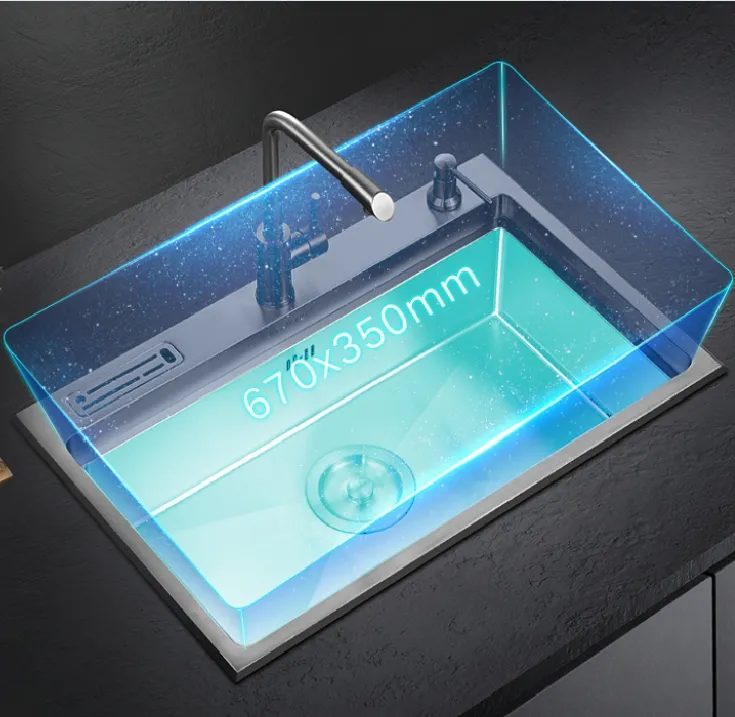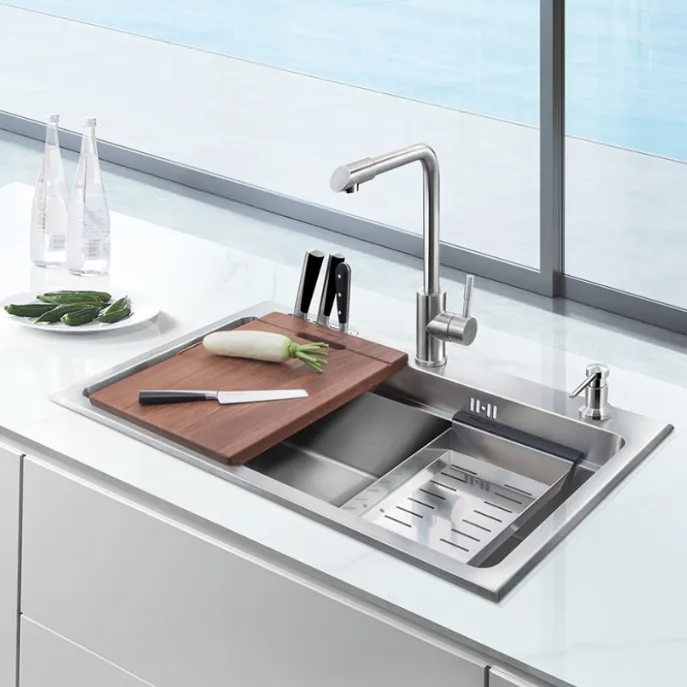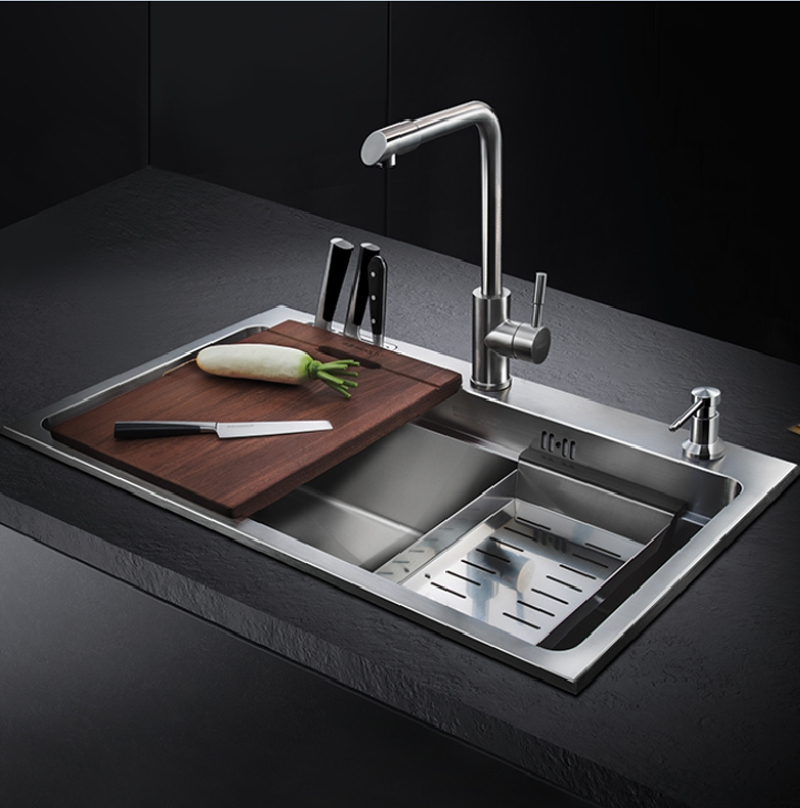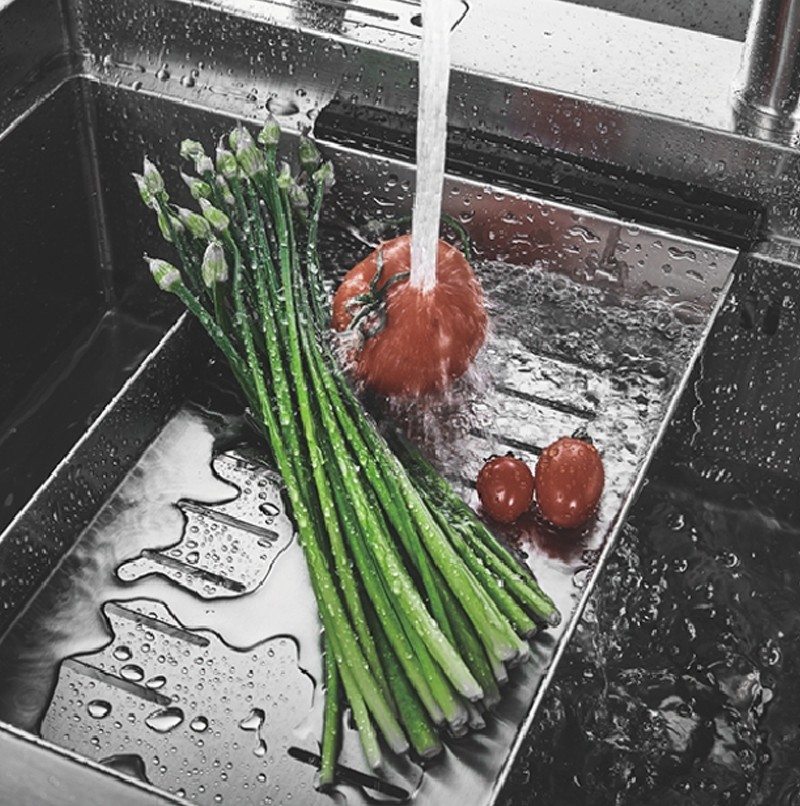The kitchen sink is a core feature of any kitchen, and multiple sinks have become a common design trend, especially in modern homes. Installing two stainless steel sinks not only improves kitchen efficiency but also provides greater flexibility for cooking and cleaning.
Whether in large or small kitchens, installing multiple sinks can meet diverse needs. However, the spacing between sinks is often overlooked, but it directly impacts the smoothness and comfort of kitchen operations.

Why is the minimum spacing between stainless steel sinks important?
When designing a kitchen, we often need to consider the spacing between sinks. While seemingly a minor detail, the spacing between sinks has a significant impact on daily use and operation. Proper spacing between sinks can effectively avoid interference during operation, improve efficiency, and ensure convenient cleaning and cooking.
If the spacing between two stainless steel sinks is too small, the cook may feel cramped and uncomfortable when performing various tasks. For example, tasks like placing dishes, washing ingredients, or preparing food can interfere with each other, creating a chaotic kitchen. Conversely, if sinks are spaced too far apart, space can be wasted, affecting the overall layout and aesthetics of the kitchen.
Therefore, understanding and selecting the appropriate sink spacing can maximize kitchen space utilization while ensuring smooth and comfortable operation.

What is the minimum spacing between kitchen sinks?
1. Common Sink Spacing Requirements
According to industry standards and kitchen design experience, the minimum spacing between sinks should be 5 inches (approximately 12.7 cm). This ensures that when two sinks are used simultaneously, the sinks do not come into direct contact with each other, and that sufficient space is provided to meet basic kitchen needs.
However, the 5-inch minimum spacing is only a basic requirement. Depending on the size of the kitchen, usage requirements, and design style, the spacing between stainless steel sinks can be increased. Wider spacing provides more room for cooking, increasing flexibility and convenience.
2. Ideal Spacing Range
In practice, many kitchen designers and sink installation experts recommend a spacing between sinks of between 8 inches (approximately 20 cm) and 12 inches (approximately 30 cm). This spacing ensures that the two sinks do not interfere with each other while still providing ample space for daily washing, food preparation, and dishware storage.
• 8-inch spacing: Suitable for average family kitchens, providing adequate working space. For most kitchens, this spacing minimizes space consumption and effectively prevents a sense of crowding.
• 12-inch spacing: Suitable for larger kitchens or homes with frequent multi-tasking. A larger spacing allows for greater independence between the two stainless steel sinks, minimizing interference. This is particularly suitable for kitchens requiring multiple work areas, such as those for simultaneous washing, cutting, and dishwashing.
3. Consider Sink Type
The type of kitchen sink also influences the required spacing between sinks. Sinks are generally categorized as single-bowl or double-bowl sinks, with double-bowl sinks coming in a wider variety of sizes and shapes. When installing two double sinks, the size, depth, and shape of the sinks need to be planned in advance to determine the optimal spacing.
• Traditional Double Sinks: For standard double sinks, a spacing of 5 to 12 inches is generally sufficient. Choosing the right sink shape and size ensures that even with a smaller spacing between the sinks, operation is not affected.
• Deep Double Sinks: Deeper sinks may require a larger spacing between the sinks, as deep sinks typically occupy more space and require more room for maneuvering. Therefore, the spacing between the sinks should be increased appropriately.
• Irregularly Shaped Sinks: For double sinks with unique designs or irregular shapes, the spacing between the sinks may be designed differently. In these cases, special attention should be paid to the coordination of the sink shape with the kitchen countertop layout to ensure smooth and aesthetically pleasing operation.

The Impact of Kitchen Sink Spacing on Smooth Operation
1. Space Efficiency
Appropriate sink spacing helps improve kitchen space efficiency. The kitchen is one of the most frequently used areas in a household, and proper space allocation and utilization are particularly important during cooking. If the distance between two kitchen sinks is too small, it can feel cramped, reducing available countertop space and hindering the smooth flow of washing ingredients, placing dishes, and cooking. If the distance is too large, it can lead to wasted space and reduce kitchen efficiency.
Appropriate spacing can maximize kitchen space utilization while avoiding interference and waste. A reasonable design ensures that two stainless steel sinks can be used simultaneously without interfering with each other, maintaining a clean and efficient kitchen.
2. Improved Convenience
When two stainless steel sinks are installed in a kitchen, multiple tasks, such as washing ingredients, cleaning dishes, and preparing food, often need to be performed simultaneously. The spacing between the sinks is particularly important in these situations. If the distance between the sinks is too small, washing ingredients, cleaning dishes, and preparing food may interfere with each other, resulting in inconvenience. Conversely, increasing the distance between kitchen sinks can provide more space for movement, making each work area more independent and improving convenience.
For example, while washing dishes, the other sink can be used to wash vegetables or fruit. Sinks with wider spacing can make operation smoother, avoid interference, and improve work efficiency.
3. Improve Comfort
Kitchen operations are often continuous, especially when cooking. Comfort directly impacts the enjoyment of kitchen work. If the spacing between sinks is too small, it can lead to overcrowding, making operation inconvenient and even affecting back posture, leading to discomfort. Appropriate sink spacing can avoid overcrowding and improve kitchen comfort.
For example, wider spacing between sinks can help cooks relax more easily, avoiding unnecessary bending and turning, making kitchen work more efficient and comfortable.
4. Avoid Water Flow Interference
In a double-bowl sink, the direction and volume of water flow are also factors to consider when considering sink spacing. If the spacing between sinks is too small, the water flow and the flow of ingredients may interfere, causing water to splash onto the countertop and making cleaning more difficult. Appropriate sink spacing can prevent water flow interference, making cleaning smoother and preventing splashing onto other areas.

The Relationship Between Sink Spacing and Kitchen Layout
The spacing between kitchen sinks should be considered not only for the size of the stainless steel sink itself but also for coordination with the overall kitchen layout. Different kitchen layouts require different spacing between stainless steel sinks. Choosing the right layout can ensure that the spacing between sinks works smoothly with other functional areas.
1. L-Shaped Kitchen
L-shaped kitchens typically have two main work areas, with the sink located on one side. Because L-shaped kitchens are relatively compact, the recommended spacing between stainless steel sinks is between 5 and 8 inches. This ensures that the two sinks do not interfere with each other when in use and maximizes available countertop space.
2. U-Shaped Kitchen
U-shaped kitchens offer more spacious working space, allowing for a relatively large spacing between the two sinks. The recommended spacing between stainless steel sinks is between 8 and 12 inches, providing ample space for washing ingredients and dishes, ensuring smooth operation.
3. Island Kitchen
Dual sinks in island kitchens are typically more spacious, allowing for greater spacing between the sinks. Because island sinks offer ample space on both sides, the spacing between stainless steel sinks can be increased to 12 inches or more for comfortable and convenient operation.
How does Higold pack products for international shipping?
Higold uses export-grade packaging with reinforced corners, protective padding, and moisture-resistant materials to ensure sinks and faucets arrive in perfect condition. Packaging can be customized with buyer branding or optimized for retail display. Proper packing reduces the risk of damage and keeps returns and complaints to a minimum.


